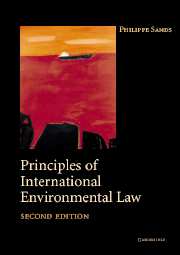Book contents
- Frontmatter
- Contents
- Foreword
- Preface and acknowledgments to the first edition
- Preface and acknowledgments to the second edition
- Table of cases
- Table of treaties and other international instruments
- List of abbreviations
- PART I The legal and institutional framework
- 1 The environment and international society: issues, concepts and definitions
- 2 History
- 3 Governance: states, international organisations and non-state actors
- 4 International law-making and regulation
- 5 Compliance: implementation, enforcement, dispute settlement
- PART II Principles and rules establishing standards
- PART III Techniques for implementing international principles and rules
- Index
4 - International law-making and regulation
- Frontmatter
- Contents
- Foreword
- Preface and acknowledgments to the first edition
- Preface and acknowledgments to the second edition
- Table of cases
- Table of treaties and other international instruments
- List of abbreviations
- PART I The legal and institutional framework
- 1 The environment and international society: issues, concepts and definitions
- 2 History
- 3 Governance: states, international organisations and non-state actors
- 4 International law-making and regulation
- 5 Compliance: implementation, enforcement, dispute settlement
- PART II Principles and rules establishing standards
- PART III Techniques for implementing international principles and rules
- Index
Summary
Introduction
R. Hahn and K. Richards, ‘The Internationalisation of Environmental Regulation’, 30 Harvard International Law Journal 421 (1989); O. Schachter, ‘The Emergence of International Environmental Law’, 44 Journal of International Affairs 457 (1991); W. Lang, ‘Diplomacy and International Environmental Law-Making: Some Observations’, 3 Yearbook of International Environmental Law 108 (1992); U. Beyerlin and T. Marauhn, ‘Law Making and Law-Enforcement in International Environmental Law after the 1992 Rio Conference’ (Berichte 4/1997); P. Sands, ‘The New Architecture of International Environmental Law’, 30 RBDI 512 (1997); A. Ahmad, Cosmopolitan Orientation of the Process of International Environmental Lawmaking: An Islamic Law Genre (2001).
This chapter identifies the sources of international legal obligation in the field of the environment, and the regulatory techniques used to give effect to these obligations. International law is traditionally stated to comprise ‘the body of rules which are legally binding on states in their intercourse with each other’. These rules derive their authority, in accordance with Article 38(1) of the Statute of the International Court of Justice (ICJ), from four sources: treaties, international custom, general principles of law, and subsidiary sources (decisions of courts and tribunals and the writings of jurists and groups of jurists). It is to these sources that the ICJ would look in determining whether a particular legally binding principle or rule of international environmental law existed. The list of sources identified in Article 38(1) does not wholly reflect the sources of obligation, broadly understood, which have arisen in international environmental law.
- Type
- Chapter
- Information
- Principles of International Environmental Law , pp. 123 - 170Publisher: Cambridge University PressPrint publication year: 2003



